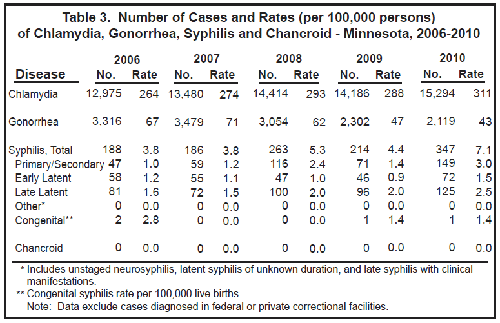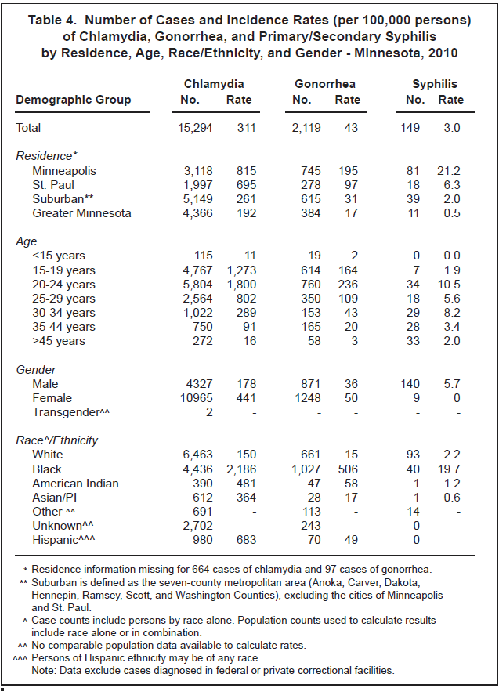Annual Summary of Disease Activity:
Disease Control Newsletter (DCN)
Related Topics
Contact Info
Sexually Transmitted Diseases, 2010
STD Diseases on this page:
Chlamydia
Gonorrhea
Syphilis
Chancroid
Active surveillance for gonorrhea and chlamydia involves cross-checking laboratory-reported cases against cases reported by clinicians. Although both laboratories and clinical facilities are required to report STDs independently of each other, a laboratory-reported case is not considered a case for surveillance purposes until a corresponding case report is submitted by the clinical facility. Case reports contain demographic and clinical information that is not available from laboratory reports. When a laboratory report is received but no corresponding case report is received within 45 days, MDH mails a reminder letter and case report form to the clinical facility. Active surveillance for syphilis involves immediate follow-up with the clinician upon receipt of a positive laboratory report. Cases of chancroid are monitored through a mostly passive surveillance system. Herpes simplex virus and human papillomavirus infections are not reportable.
Although overall incidence rates for STDs in Minnesota are lower than those in many other areas of the United States, certain population subgroups in Minnesota have very high STD rates. Specifically, STDs disproportionately affect adolescents, young adults, and persons of color.
Chlamydia
Chlamydia trachomatis infection is the most commonly reported infectious disease in Minnesota. In 2010, 15,294 chlamydia cases (311 per 100,000 population) were reported, representing an 8% increase from 2009 (Table 3).
Adolescents and young adults are at highest risk for acquiring chlamydial infection (Table 4). The chlamydia rate is highest among 20 to 24-year-olds (1,800 per 100,000), with the next highest rate among 15 to 19-year-olds (1,273 per 100,000). The incidence of chlamydia among adults 25 to 29 years of age (802 per 100,000) is considerably lower but has increased in recent years. The chlamydia rate among females (441 per 100,000) is more than twice the rate among males (178 per 100,000), a difference most likely due to more frequent screening among women.
The incidence of chlamydia infection is highest in communities of color (Table 4). The rate among blacks (2,186 per 100,000) is 15 times higher than the rate among whites (150 per 100,000). Although blacks comprise approximately 4% of Minnesota’s population, they account for 29% of reported chlamydia cases. Rates among Asian/Pacific Islanders (364 per 100,000), American Indians (481 per 100,000), and Hispanics (683 per 100,000) are over two to five times higher than the rate among whites.
Chlamydia infections occur throughout the state, with the highest reported rates in Minneapolis (815 per 100,000) and St. Paul (695 per 100,000). While there was an overall increase across the state in 2010 the greatest increase for chlamydia was seen in the suburban area (metropolitan area excluding Minneapolis and St. Paul) with a increase of 12% shown in Table 4.
Gonorrhea
Gonorrhea, caused by Neisseria gonorrhoeae, is the second most commonly reported STD in Minnesota. In 2010, 2,119 cases (43 per 100,000 population) were reported, representing a 34% decrease from 2009 (Table 3).
Adolescents and young adults are at greatest risk for gonorrhea (Table 4), with incidence rates of 164 per 100,000 among 15 to 19-year-olds, 236 per 100,000 among 20 to 24-year olds, and 109 per 100,000 among 25 to 29-year-olds. Gonorrhea rates for males (36 per 100,000) and females (50 per 100,000) are comparable. Communities of color are disproportionately affected by gonorrhea, with nearly one half of cases reported among blacks. The incidence of gonorrhea among blacks (506 per 100,000) is 34 times higher than the rate among whites (15 per 100,000). Rates among Asian/Pacific Islanders (17 per 100,000), American Indians (58 per 100,000), and Hispanics (49 per 100,000) are up to four times higher than among whites.
Gonorrhea rates are highest in the cities of Minneapolis and St. Paul (Table 4). The incidence in Minneapolis (195 per 100,000) is two times higher than the rate in St. Paul (97 per 100,000), nearly six times higher than the rate in the suburban metropolitan area (31 per 100,000), and over 11 times higher than the rate in Greater Minnesota (17 per 100,000). Geographically in 2010, Minneapolis saw a 3% increase in cases with St. Paul seeing the greatest drop in cases at 31%.
The emergence of quinolone-resistant N. gonorrhoeae (QRNG) in recent years has become a particular concern. Due to the high prevalence of QRNG in Minnesota as well as nationwide, quinolones are no longer recommended for the treatment of gonococcal infections.
Syphilis
Surveillance data for primary and secondary syphilis are used to monitor morbidity trends because they represent recently acquired infections. Data for early syphilis (which includes primary, secondary, and early latent stages of disease) are used in outbreak investigations because they represent infections acquired within the past 12 months and signify opportunities for disease prevention.
Primary and Secondary Syphilis
The incidence of primary/secondary syphilis in Minnesota is lower than that of chlamydia or gonorrhea (Table 3), but has remained elevated since an outbreak began in 2002 among men who have sex with men (MSM). In 2010, there were 149 cases of primary/secondary syphilis in Minnesota (3.0 cases per 100,000 persons). Notably, this represents an increase of 110% compared to the 71 cases (1.4 per 100,000 population) reported in 2009.
Early Syphilis
In 2010, the number of early syphilis cases increased by 89%, with 221 cases occurring compared to 117 cases in 2009. The incidence remains highly concentrated among MSM. Of the early syphilis cases in 2010, 208 (94%) occurred among men; 185 (89%) of these men reported having sex with other men; 57% of the MSM diagnosed with early syphilis were co-infected with HIV.
Congenital Syphilis
One case of congenital syphilis was reported in Minnesota in 2010 (Table 3).
Chancroid
No cases were reported in 2009. The last case was reported in 1999.


- For up to date information see>> Sexually Transmitted Diseases (STDs)
- Full issue>> Annual Summary of Communicable Diseases Reported to the Minnesota Department of Health, 2010